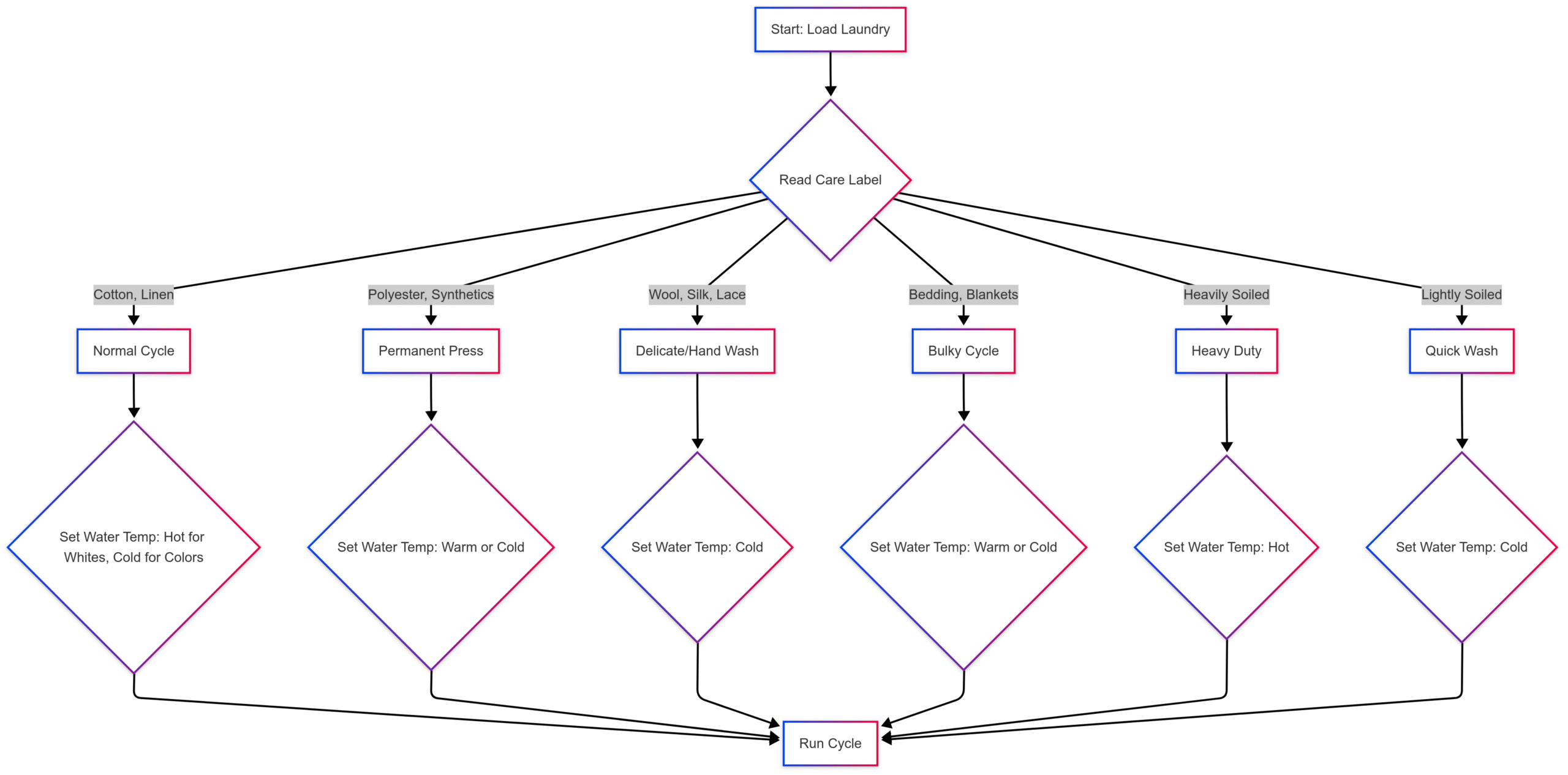A Complete Guide To Washing Machine Cycles
Discover the ultimate guide to washing machine cycles, from normal to delicate, with expert tips to choose the right cycle for your clothes. Optimize laundry results!
Washing machines are indispensable household appliances, yet their array of cycles and settings can feel overwhelming. From normal to delicate, bulky to quick wash, each cycle serves a specific purpose, tailored to different fabrics, soil levels, and laundry needs. This comprehensive guide demystifies washing machine cycles, explaining how they work, when to use them, and why they matter. By understanding these cycles, you can extend the life of your clothes, save energy, and achieve cleaner results. Let’s dive into the mechanics of washing machine cycles and how to choose the right one for every load.
How Washing Machines Work: The Basics
At their core, washing machines clean clothes through a sequence of stages: pre-wash, main wash, rest period, rinse, and spin. These stages are orchestrated differently depending on the selected cycle, which adjusts water temperature, agitation intensity, spin speed, and cycle duration. Here’s a step-by-step breakdown of how a washing machine operates:
- Load Sensing: Modern machines assess the load size to optimize water and detergent use. High-efficiency (HE) models are particularly adept at this, ensuring minimal waste.
- Pre-Wash: An optional stage for heavily soiled items, using cold or warm water to loosen dirt before the main wash.
- Main Wash: The drum fills with water, detergent is dispensed, and agitation (or tumbling in front-loaders) removes dirt and stains.
- Rest Period: A brief pause allows detergent and dirt to settle, enhancing cleaning efficiency.
- Rinse: Dirty water is drained, and fresh water is added to remove residual detergent and debris. Some cycles include multiple rinses.
- Spin: The drum spins at high speeds (measured in revolutions per minute, or RPM) to extract excess water, preparing clothes for drying.
Each cycle modifies these stages to suit specific fabrics or cleaning needs, balancing agitation, water temperature, and spin speed to protect clothes while ensuring cleanliness.
Core Washing Machine Cycles Explained
Most washing machines offer a range of cycles, from standard options like normal and delicate to specialized settings like bulky or quick wash. Below is a detailed exploration of the seven most common cycles, their mechanics, and their ideal applications.
1. Normal (Regular or Cotton) Cycle
The normal cycle, also called regular or cotton, is the workhorse of washing machine settings. It’s designed for durable fabrics like cotton, linen, and synthetic blends commonly found in T-shirts, socks, underwear, sheets, and towels. This cycle features:
- High agitation: Vigorous drum movement to tackle dirt and stains.
- High spin speed: Typically 1200–1400 RPM to extract maximum water, reducing drying time.
- Water temperature: Adjustable (hot for whites, 40–60°C; cool for colors, 20–30°C).
- Duration: Approximately 60 minutes, depending on the machine.
When to Use: Choose the normal cycle for everyday laundry, especially heavily soiled items like gym clothes or kitchen towels. Always check care labels to confirm fabric compatibility.
Pro Tip: For whites, hot water enhances stain removal, but cold water is sufficient for most colors to prevent fading.
2. Permanent Press (Colors) Cycle
The permanent press cycle emerged in the 1940s with the rise of synthetic, wrinkle-resistant fabrics. It’s gentler than the normal cycle, balancing cleaning power with fabric care. Key features include:
- Moderate agitation: Fast enough to clean but less intense to protect synthetic fibers.
- Low spin speed: Around 800–900 RPM to minimize creasing.
- Warm water: Typically 30–40°C, though cold is an option for delicate synthetics.
- Duration: Shorter than normal, around 40–50 minutes.
When to Use: Ideal for jeans, polyester, and non-cotton items prone to wrinkling, like dress shirts or blouses. It’s not suitable for hand-wash-only items or ultra-delicate fabrics.
Pro Tip: Permanent press is excellent for mixed loads with natural fibers that crease easily, but avoid it for silk or wool.
3. Delicate (Hand Wash) Cycle
The delicate cycle mimics hand washing, offering the gentlest treatment for fragile fabrics. It’s designed to minimize wear and tear on delicate materials. Characteristics include:
- Low agitation: Slow drum movement to prevent stretching or tearing.
- Low or no spin: Speeds as low as 400–500 RPM to protect fibers.
- Cold or warm water: Cold (20–30°C) is recommended to avoid shrinking.
- Duration: 30–60 minutes, depending on the machine.
When to Use: Perfect for wool, silk, lace, lingerie, hosiery, cashmere, merino, and delicate synthetics. It’s also suitable for lightly soiled cottons or synthetics when in doubt.
Pro Tip: Use a mesh laundry bag to prevent snagging and extend garment life. Always opt for cold water unless the care label specifies otherwise.
4. Quick Wash (Speed Wash) Cycle
The quick wash cycle is a time-saver for lightly soiled or small loads. It prioritizes speed over thorough cleaning, making it ideal for refreshing clothes. Features include:
- Moderate agitation: Sufficient to clean lightly soiled items.
- High spin speed: 1200–1400 RPM for faster drying.
- Cold water: Typically used to save energy and protect colors.
- Duration: 15–40 minutes, depending on the machine.
When to Use: Use for small loads, lightly soiled clothes, or items forgotten in the washer that need a quick refresh.
Pro Tip: Avoid overloading the machine on quick wash to ensure even cleaning.
5. Heavy Duty Cycle
The heavy duty cycle is designed for tough stains and heavily soiled items, such as work clothes, towels, or bedding. It offers:
- Intense agitation: Maximum cleaning power for stubborn dirt.
- High spin speed: 1200–1400 RPM to remove excess water from heavy fabrics.
- Hot water: Often 40–60°C for enhanced stain removal.
- Duration: 60–120 minutes, depending on the machine.
When to Use: Ideal for heavily soiled items like muddy sports uniforms, greasy workwear, or thick towels.
Pro Tip: Pair with a pre-wash cycle for extra-dirty loads to loosen soil before the main wash.
6. Bulky Cycle
The bulky cycle is tailored for large, heavy items like blankets, comforters, or sleeping bags. It uses:
- Low agitation: Gentle movement to prevent damage to bulky items.
- High water levels: Ensures thorough cleaning of large loads.
- Moderate spin speed: Around 800–1000 RPM to balance water extraction and fabric care.
- Duration: 60–90 minutes.
When to Use: Best for bedding, blankets, and large items that need extra space and water to clean effectively.
Pro Tip: Check care labels for delicate materials like silk curtains, which may require dry cleaning instead.
7. Rinse and Spin Cycle
The rinse and spin cycle is a standalone option to remove detergent residue or refresh clothes. It includes:
- No agitation: Focuses solely on rinsing and spinning.
- High spin speed: 1200–1400 RPM to extract water.
- Cold water: Prevents color bleeding.
- Duration: 10–20 minutes.
When to Use: Use to remove excess detergent, rinse soiled clothes before a heavy-duty cycle, or refresh items with minimal cleaning.
Pro Tip: This cycle is great for pre-treating stains before a full wash.
Additional Washer Settings and Features
Beyond cycles, washing machines offer settings that fine-tune the washing process. Understanding these can further optimize your laundry routine.
Water Temperature
Water temperature significantly impacts cleaning and fabric care. Modern detergents work well in cold water (20–30°C), reducing energy use and preventing color fading. Hot water (40–60°C) is best for:
- Grease-stained or heavily soiled clothes.
- White cotton items.
- Bedding and towels for sanitization.
Caution: Avoid hot water for delicate fabrics like silk or wool, as it can cause shrinking or felting.
Spin Speed
Spin speed, measured in RPM, determines how much water is extracted during the spin cycle. Common settings include:
- High (1200–1400 RPM): Normal and heavy-duty cycles for durable fabrics like cotton.
- Medium (800–900 RPM): Permanent press for synthetics and jeans.
- Low (400–500 RPM): Delicate cycles for fragile fabrics.
Higher spin speeds reduce drying time but can damage delicate fibers. Most machines automatically adjust spin speed based on the cycle, but manual overrides are available for customization.
Soil Level
Soil level settings (low, medium, high) adjust agitation intensity and cycle duration based on dirtiness. For example:
- Low: Lightly soiled clothes, like worn-once shirts.
- Medium: Everyday laundry with moderate dirt.
- High: Heavily soiled items, like muddy sports gear.
Water Level and Auto-Sensing
Traditional top-load washers use 30–45 gallons per cycle, while HE models use as little as 14 gallons. Auto-sensing technology measures load size to optimize water use, but manual adjustments are possible for specific needs.
Steam Clean
Some washers feature a steam clean option, which uses steam to:
- Remove tough stains and grime.
- Sanitize clothes.
- Reduce wrinkles and musty odors.
When to Use: Ideal for refreshing clothes or sanitizing bedding.
Extra Options
Modern machines may include:
- Pre-Wash: A cold-water cycle to loosen dirt before the main wash.
- Soak Mode: Extends soaking time for stain removal.
- Delayed Start: Schedules the wash for later, ideal for off-peak energy hours.
- Eco-Mode: Reduces water and energy use for environmentally conscious washing.
Top Load vs. Front Load Washers
Washing machines come in two primary designs: top-load and front-load, each with distinct cleaning mechanisms.
| Feature | Top-Load Washer | Front-Load Washer |
|---|---|---|
| Cleaning Action | Agitator or impeller | Tumbling action |
| Water Usage | Higher (30–45 gallons) | Lower (14–20 gallons) |
| Cycle Duration | Shorter (30–60 minutes) | Longer (45–90 minutes) |
| Fabric Care | Good for heavy loads | Gentler on delicate fabrics |
| Energy Efficiency | Less efficient | More efficient (HE models) |
Top-Load Washers:
- Use an agitator (central post) or impeller (low-profile cone) to agitate clothes.
- Ideal for heavy loads and quick cycles.
- Example: Whirlpool® 2-in-1 Removable Agitator allows switching between agitator and impeller modes.
Front-Load Washers:
- Use a tumbling action, gentler on clothes.
- More water- and energy-efficient, but cycles are longer.
- Example: HE front-loaders use less water and specialized HE detergent for optimal cleaning.
Agitators vs. Impellers
Top-load washers clean using either an agitator or impeller:
- Agitator: A central post twists back and forth, rubbing against clothes to remove dirt. Best for heavily soiled loads but can be harsh on delicate fabrics.
- Impeller: A low-profile cone or disc rotates to rub clothes gently against each other. Ideal for regular loads and gentler cleaning.
Example: Whirlpool’s 2-in-1 Removable Agitator offers flexibility to switch between modes based on load type.
Washer-Dryer Combos
Washer-dryer combos combine washing and drying in one machine. They function like front-load washers for cleaning, using a tumbling action, and switch to heated tumble drying. These are ideal for small spaces but may have longer cycle times.
Cycle Selection Guide: Which Cycle for Which Fabric?
Choosing the right cycle depends on fabric type, soil level, and care label instructions. Below is a guide to match cycles with common fabrics:
| Fabric Type | Recommended Cycle | Water Temperature | Spin Speed (RPM) |
|---|---|---|---|
| Cotton, Linen | Normal | Hot (whites), Cold (colors) | 1200–1400 |
| Polyester, Synthetics | Permanent Press | Warm or Cold | 800–900 |
| Wool, Silk, Lace | Delicate/Hand Wash | Cold | 400–500 |
| Bedding, Blankets | Bulky | Warm or Cold | 800–1000 |
| Heavily Soiled Items | Heavy Duty | Hot | 1200–1400 |
| Lightly Soiled Items | Quick Wash | Cold | 1200–1400 |
Chart: Washing Machine Cycle Decision Flow

Expert Tips for Optimal Laundry Results
- Check Care Labels: Always follow garment care instructions to avoid damage.
- Use Mesh Bags: Protect delicate items from snagging during the wash.
- Avoid Overloading: Ensure clothes have room to move for thorough cleaning.
- Use HE Detergent for HE Washers: Low-sudsing formulas optimize performance.
- Clean Your Machine: Run a cleaning cycle monthly to prevent mold and odors.
- Leave the Door Open: For front-loaders, this prevents musty smells.
- Line-Dry Delicates: Avoid dryers for wool, silk, and delicate synthetics to prevent fading or damage.
Common Washing Machine Models and Specifications
Here’s a look at popular washing machine models, their key features, and approximate prices (based on typical market ranges):
| Model | Type | Key Features | Approx. Price (USD) |
|---|---|---|---|
| Whirlpool WTW8127LC | Top-Load | 2-in-1 Removable Agitator, 5.3 cu. ft. | $1,200–$1,400 |
| Samsung WF45T6000AW | Front-Load | AddWash Door, Steam Clean, 4.5 cu. ft. | $900–$1,100 |
| LG WM4000HBA | Front-Load | TurboWash, SmartThinQ, 4.5 cu. ft. | $1,000–$1,300 |
| Speed Queen TR7 | Top-Load | Commercial-Grade Durability, 3.2 cu. ft. | $1,300–$1,600 |
| GE GFW850SPNRS | Front-Load | UltraFresh Vent System, 5.0 cu. ft. | $1,100–$1,400 |
Note: Prices vary by retailer and region. Check manufacturer websites for exact specifications and current pricing.
FAQs About Washing Machine Cycles
The delicate and hand wash cycles are similar, both using low agitation and spin speeds. However, some machines offer a separate hand wash cycle with even gentler settings for ultra-delicate fabrics like silk or cashmere, often with longer rest periods and higher water levels to cushion clothes.
A dark or colors cycle often combines cold water with moderate agitation and lower spin speeds to prevent fading and stretching, offering a tailored approach compared to manually selecting cold water on a normal cycle.
Hot water (40–60°C) enhances stain removal and sanitization but can fade colors or shrink delicate fabrics. Cold water (20–30°C) is energy-efficient and safe for most fabrics, especially colors and delicates.
Most machines automatically set appropriate spin speeds, but manual adjustments can speed up drying (higher RPM) or protect delicate fabrics (lower RPM).
Conclusion
Mastering washing machine cycles is key to preserving your clothes, saving energy, and achieving optimal cleaning results. By understanding the differences between normal, permanent press, delicate, and other cycles, you can make informed choices based on fabric type and soil level. Pair this knowledge with care label instructions and modern features like auto-sensing or steam clean for a laundry routine that’s efficient and effective. Whether you’re washing everyday cottons or delicate silks, the right cycle makes all the difference.
For those seeking professional laundry services, companies like Rinse offer pickup, cleaning, and delivery, ensuring your clothes are treated with care. Explore their services at Rinse.com for a hassle-free experience.
Please share this A Complete Guide To Washing Machine Cycles your friends and do a comment below about your feedback.
We will meet you on next article.
Until you can read, Pros and Cons of Different Wood Types for Furniture






